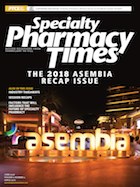Publication
Article
Specialty Pharmacy Times
Industry Takeaways From Asembia
As it is every year, the Asembia Summit was filled with a plethora of information that allowed for networking, business development, and personal development.
The Asembia Specialty Pharmacy Summit continued to grow this year, setting a record by welcoming more than 6500 industry professionals representing more than 1000 organizations, including health care providers, payers, manufacturers, health systems, wholesal-ers, and many other industry players.
During the conference, attendees had the opportunity to take part in a multitude of workshops, educational seminars, vendor exhibits, business meetings, and live continuing education training. There was also the opportunity to engage in a number of networking and social events that allowed us to connect with a multitude of industry professionals throughout the summit. During the general session, moderated by CNN political analyst David Gregory, a group of industry experts from Asembia, CastiaRx, OptumRx, and UCB discussed trends, disruptions, innovative technology, and their viewpoints on how these changes are affecting the industry. One of the key takeaways from the discussion was that supply chain departments are trying to solve problems from their own perspective. As a result, there is a need for our specialty pharmacy industry to work together to solve our problems as an industry, or we open the door for the potential of the government’s stepping in and dictating solutions for us.
Another panel session included speakers Adam Fein, PhD, CEO of Drug Channels Institute; Lisa Gill, managing director of J.P. Morgan Securities; and Doug Long, vice president of Industry Relations at IQVIA. Fein, Gill, and Long discussed specialty pharmacy from a financial viewpoint as well as an overall industry outlook.
Fein highlighted several industry stats pointing to the growth of specialty phar- macy. According to Fein’s research, there has been an acceleration in the battle to control the specialty market, and the number of specialty pharmacies with accreditation has expanded. In 2017, there were 729 accredited pharmacies, up by 46% since 2016. Fein said he expects this trend to continue and that by next year, there will be more than 1000 pharmacies accredited. He also projects that by 2022, specialty drugs will account for 47% of the industry’s total pharmacy revenue.
Gill discussed how payers are looking for better ways to manage patients with complex conditions. She said they are investigating this partially because specialty drug costs are expected to be nearly 55% of drug spend by 2020. Because of this increased cost, Gill said, specialty costs will drive more vertical integration in the future, allowing companies to gain more detailed patient insights, drive better health outcomes, and manage costs.
Some interesting takeaways from Long’s presentation included:
- Specialty spend in 2017 grew by 9.3%, while traditional pharmacy spend declined by 4%.
- In 2017, the majority of new specialty medications launched in the United States were considered orphan drugs. Oncology, infectious disease, and central nervous system treatments pre- dominantly drove this category.
- Six key issues facing market access teams: Consolidation in payer management Higher out-of-pocket payments for patients Demand for price transparency from the public More stringent medical benefit management ÌŠ Increase in value-based models Evolving provider landscape
In another presentation at the summit, Kylanne Green, president and CEO of URAC, provided a unique perspective on the ever-changing specialty market dynamics. She discussed something that I believe many of us have been thinking about: What is in store for specialty pharmacy in the future, and how do we prepare for it? Green mentioned that the industry is moving incredibly fast and touched on how companies will strive to stay relevant in this environment.
She also addressed the hot new trend of mergers and acquisitions, not just vertical industry mergers but also new hybrid mergers that have never been seen in specialty. The movers and shakers in specialty pharmacy are constantly innovating to stay competitive. Green then went on to discuss URAC accreditation and the need for specialty pharmacies to provide a higher level of treatment for patients so that desired outcomes will be achieved. She predicted that this trend will continue, with more specialty pharmacies looking to earn 1 or more accreditations.
Another excellent session I attended was a specialty pipeline product update presented by Ray Tancredi, divisional vice president of Specialty Pharmacy Development and Brand Rx/Vaccine Purchasing at Walgreens—and not just because I work for Walgreens! Tancredi has been giving this pipeline presentation for many years now, and attendees are often buzzing before and after his presentation about what they learned. During this presentation, Tancredi described trends in specialty drug development, highlighted specialty drug approvals, and outlined the pipeline of products by disease state.
Some of the key points included:
- The year 2017 was a strong one for innovation, as the FDA approved a record number of novel and biological drugs, 56 to be exact.
- This past year recorded the highest annual total of generic drug approvals (1027) in the history of the FDA. If the current trends continue, Tancredi estimates, approvals in 2018 will exceed this record number.
- The pipeline for gene therapies is robust. There are 985 in vivo gene therapies in addition to 354 chimeric antigen receptor T-cell therapies currently in pipeline development. Most are at an early stage of development, with more than three-quarters at the discovery or preclinical stage.
- There are currently 23 gene therapy programs in phase 3 development. As it is every year, the Asembia Summit was filled with a plethora of information that allowed for networking, business development, and personal development. This is definitely a must-attend event for anyone involved in the specialty pharmacy industry.







